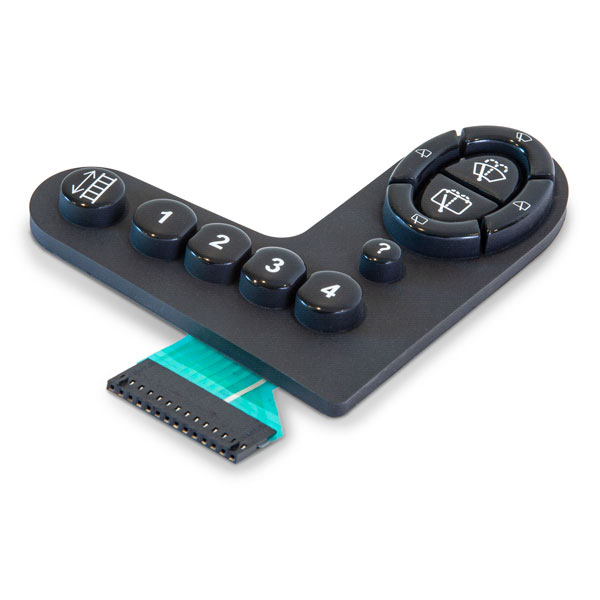Recognizing Membrane Switches Over: The Key to Trustworthy and durable Controls

What Are Membrane Switches?
Membrane layer switches are an advanced option in the world of customer interface innovation, integrating capability and design effortlessly. These gadgets function as a user interface in between customers and digital systems, incorporating several components into a small style. Commonly constructed from flexible, thin layers of materials, membrane switches are designed to react to touch, enabling individuals to engage with equipment and digital tools properly.
The key elements of a membrane switch include a printed circuit layer, graphic overlay, and a spacer layer that avoids unexpected activation. The visuals overlay can be tailored to mirror brand name identification or user preferences, enhancing visual appeals while making certain use. Membrane buttons are generally made use of in various applications, including medical gadgets, customer electronic devices, and industrial equipment, owing to their longevity and resistance to environmental aspects such as moisture and dust.
One of the crucial advantages of membrane layer buttons is their capacity to hold up against wear and tear, making them suitable for high-traffic atmospheres. Furthermore, they are lightweight and need marginal area, permitting ingenious designs in product development. On the whole, membrane changes represent a reliable and sensible option for modern digital interfaces, weding technology with user-centric layout principles.
Just How Membrane Switches Over Work
The operation of membrane layer switches joints on a simple yet reliable mechanism that converts user input right into electronic signals. These switches consist of several layers, generally consisting of a graphic overlay, a spacer layer, and a circuit layer. When an individual presses the switch, the top layer deforms, allowing a conductive element in the circuit layer to make contact with a corresponding conductive pad on the bottom of the visuals overlay. This call shuts the circuit and sends an electronic signal to the gadget, indicating that the switch has actually been activated.
The style of membrane layer switches can differ, yet they frequently include domes or responsive elements to supply responses to the customer, improving the total experience - membrane switch. The products used in membrane layer buttons, such as polyester or polycarbonate, add to their toughness and resistance to environmental variables, including wetness and dirt. Moreover, the published circuits are typically encapsulated, which secures them from damage in time.
Benefits of Membrane Buttons

In addition, membrane buttons are understood for their resilience. Built from robust materials, they are immune to dust, moisture, and physical wear, which substantially prolongs their life-span contrasted to typical More Help mechanical switches. This resilience makes them especially ideal for high-traffic environments and applications needing long life.
Another considerable advantage is the convenience of cleaning and maintenance. The smooth surface of membrane changes decreases dirt buildup and is frequently invulnerable to spills, making them ideal for settings that require frequent sanitization.
Additionally, membrane layer switches provide a structured profile, resulting in a thinner style that can be integrated into different gadgets without adding bulk. This feature not only enhances the aesthetic appeal but additionally adds to a much more ergonomic product style.
Applications of Membrane Switches
Straightforward and functional, membrane buttons discover applications throughout a large range of sectors, consisting of medical gadgets, consumer electronic devices, and commercial devices. In the medical field, these buttons are integral to tools such as diagnostic tools, individual surveillance systems, and mixture pumps, where reliability and simplicity of cleaning are vital. Their ability to hold up against extreme environments and keep capability makes them optimal for such applications.

In consumer electronic devices, membrane buttons are used in products like microwaves, cleaning machines, and push-button controls - membrane switch. Their streamlined design permits for intuitive interface, enhancing the general user experience while offering resilience and resistance to tear and wear
Commercial equipment likewise profits from membrane switches, especially in control panels for equipment and automation systems. These switches provide defense against dust and dampness, ensuring constant efficiency in challenging environments. Moreover, their customizable features enable suppliers to tailor them to particular operational requirements, boosting performance and her explanation functionality.
Selecting the Right Membrane Change
When picking a membrane layer button, it is important to think about different elements that affect performance and viability for specific applications. The key considerations consist of environmental conditions, responsive responses, sturdiness, and style specifications.
First, evaluate the operating environment; buttons revealed to wetness, chemicals, or extreme temperatures call for details products to guarantee longevity and functionality. Next off, review the requirement for tactile feedback. Relying on customer communication, some applications might take advantage of a tactile reaction to validate activation, while others may prefer a non-tactile style for aesthetic factors.
Longevity is one more important element; membrane layer buttons should be made to stand up to regular use, effects, and abrasion. Guarantee the picked switch can sustain the the original source expected lifecycle, particularly in high-usage circumstances.

Conclusion
In verdict, membrane switches over serve as crucial elements in the design of reliable and long lasting control systems across numerous industries. The adaptability of membrane layer changes permits for tailored options that satisfy details functional requirements, enhancing their importance in modern-day innovation.
Membrane switches represent an essential aspect of contemporary user interface layout, mixing capability with resilience in various applications.Membrane switches are an advanced remedy in the world of customer interface technology, combining functionality and design perfectly. Normally created from adaptable, slim layers of products, membrane layer buttons are made to respond to touch, enabling users to connect with equipment and digital gadgets successfully.
The layout of membrane layer buttons can vary, however they typically integrate domes or responsive components to supply comments to the individual, improving the general experience.In conclusion, membrane switches serve as important components in the design of resilient and trustworthy control systems throughout different markets.
Comments on “Explore the Benefits of Using a Membrane Switch in Modern Devices”